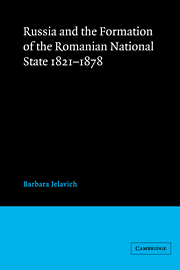Book contents
- Frontmatter
- Contents
- List of maps and illustrations
- Preface
- Introduction: The establishment of Russian influence in the Danubian Principalities
- I The Russian protectorate
- II The European guardianship
- III The Cuza era, 1859–1866
- IV Prince Charles, 1866–1871
- V Prince Charles, 1871–1878: the Eastern crisis
- Conclusion
- Notes
- Bibliography
- Index
- Plate section
- Frontmatter
- Contents
- List of maps and illustrations
- Preface
- Introduction: The establishment of Russian influence in the Danubian Principalities
- I The Russian protectorate
- II The European guardianship
- III The Cuza era, 1859–1866
- IV Prince Charles, 1866–1871
- V Prince Charles, 1871–1878: the Eastern crisis
- Conclusion
- Notes
- Bibliography
- Index
- Plate section
Summary
In the previous pages the close relationship between tsarist Russia and the Danubian Principalities has been traced from the 1820s to the achievement of Romanian independence in 1878. The narrative has shown, on the one hand, the extreme difficulties that can be encountered by a great power in dealing with a small peripheral state occupying a strategical geographic position, whose policies might at times contain dangers for its large neighbor. On the other hand, the account has stressed the parallel problems met by a Balkan nation, with a highly conscious national leadership, in handling the great power whose attitude was critical for its political development. The support or at least the acquiescence of Russia was essential for the attainment of the major Romanian goals. The intervention of tsarist officials was thus often requested. Care had to be taken, however, that this assistance did not result in the complete domination of the country or in its annexation. The balance, as we have seen, was precarious. Romanian leaders usually followed a policy of seeking Russian aid against the Ottoman suzerain, but also of calling upon other governments to block a domination of their nation by Russia.
Russian policies toward the Romanian national movement were similarly ambivalent. Although some plans were indeed made for the partition of the Balkan peninsula, with the Principalities as a part of their sphere, the majority of the Russian leaders, tsars and diplomats alike, favored an indirect approach. In fact, the preferred policy throughout much of the nineteenth century, exemplified by the Treaty of Unkiar Iskelesi, was the control of the central Ottoman government and thus of the entire empire.
- Type
- Chapter
- Information
- Publisher: Cambridge University PressPrint publication year: 1984

